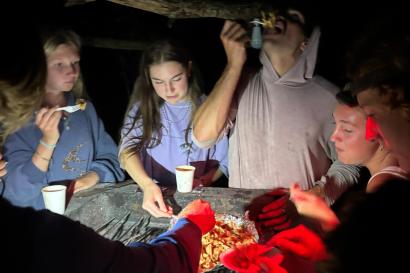For my first three weeks here, I am enrolled in one course: tropical ecology. Class takes place in a purple, stucco building on the university campus for three hours a day, four days a week. To the delight of a classroom full of amateur field biologists, though, most of our class days are spent outside. We take trips to many different ecosystems within this incredibly biodiverse country and learn more than we ever could inside walls, no matter how vibrant their color might be.
Our first trip took us up to the páramo, an alpine ecosystem occurring in patches in the Northern Andes, between the tree line and the perpetual snow border above it. The páramo’s environmental conditions (high winds, a wide diurnal temperature range, and high exposure to UV light) have prompted some trends in evolutionary adaptations for life in this harsh, high-altitude habitat. The flora of the páramo exhibits effective strategies for overcoming cold temperatures by creating tiny microclimates. They boast furry, fuzzy leaves, or droop their flower heads to shelter their seeds from the wind. Cushion plants grow in mats close to the ground, and can consist of up to twenty species living in close coexistence. Grasses shield their tissues from equatorial UV rays by retaining high amounts of dead, brown biomass, creating a landscape seemingly devoid of green until you look closer at the diversity of asters and the gentians blooming purple and pink. The grasses cover ancient volcanic cones, which are partially caved in to create an otherworldly scene of endless rolling hummocks swept by constant, fast-moving mist. The clouds rise up over the valleys to reveal clear lakes carved long ago by alpine glaciers.

Though it was a landscape completely foreign and strange to me, the páramo reminded me of a more familiar mountain ecosystem: the tundra of northern Maine. While doing conservation work above treeline on the tallest mountain in my New England state, I’ve gotten to know the fragile flora that exists there, still surviving on the mountaintop after being left behind by a retreating glacier 10,000 years ago. What struck me while hiking through the Ecuadorian páramo was the morphological similarity between some of the plants of these two different habitats. Species compositions are extremely different, but there are consistent environmental conditions present in both alpine zones which have prompted the coevolution of a few adaptive features.

This species of Aster boasts fuzzy leaves reminiscent of those of one of my favorite Northern plants of the Heath family, Labrador Tea, though the two are quite unrelated.

These massive cushion plants generate microclimatic conditions favorable for life in the freezing rain and winds. Their low-lying, mat-like growth form reminds me of Diapensia lapponica, which grows for hundreds of years while crouching low on the mountaintops of Northern Maine.
Selective pressure for adaptations such as pubescent leaves and growth in low-lying mats seems to be higher in the páramo, where conditions are intensified due to altitude and other geographical factors, yielding more dramatic adaptive traits. It would be interesting to study the factors that lead to the higher floral biodiversity present in the páramo in the face of such harsh conditions in comparison to other less-diverse alpine ecosystems worldwide.

Grace Glynn
<p><span style="color: rgb(29, 29, 29); font-family: Arial, Verdana, sans-serif; font-size: 12px; line-height: normal; background-color: rgb(237, 237, 237);">Grace is a junior at Connecticut College with a major in botany. She grew up on the coast of Maine and looks forward to leaving its harsh winter for the equatorial Galapagos Islands. Grace’s interests include paleontology, backpacking, folk music, and fermented foods. Join her as she heads to Ecuador for the semester!</span></p>






